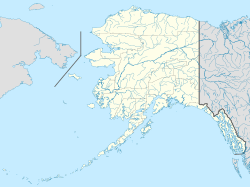Angoon, Alaska facts for kids
Quick facts for kids
Angoon, Alaska
Aangóon
|
|
|---|---|

St. John the Baptist Russian Orthodox Church, Angoon
|
|
| Country | United States |
| State | Alaska |
| Census Area | Hoonah-Angoon |
| Incorporated | May 7, 1963 |
| Area | |
| • Total | 38.97 sq mi (100.93 km2) |
| • Land | 24.53 sq mi (63.54 km2) |
| • Water | 14.44 sq mi (37.39 km2) |
| Elevation | 23 ft (7 m) |
| Population
(2020)
|
|
| • Total | 357 |
| • Density | 14.55/sq mi (5.62/km2) |
| Time zone | UTC-9 (Alaska) |
| • Summer (DST) | UTC-8 (Alaska) |
| ZIP code |
99820
|
| Area code | 907 |
| FIPS code | 02-03440 |
| GNIS feature ID | 1420113 |
Angoon (also called Aangóon in the Tlingit language) is a small city in Alaska, United States. It is located on Admiralty Island. In 2020, about 357 people lived there. The name Aangóon means "isthmus town" in Tlingit. An isthmus is a narrow strip of land connecting two larger land areas.
Contents
History of Angoon
Admiralty Island has long been the home of the Kootznoowoo Tlingit people. Their name, Xootsnoowú Ḵwáan, means "fortress of brown bears." Angoon was a special place for the Tlingit because it had less rain than other parts of southeastern Alaska.
Early Trading and Whaling
From the 1700s to the mid-1800s, when Russia controlled Alaska, maritime fur trading was very important. After the United States bought Alaska in 1867, the North West Trading Company set up a trading post and whaling station nearby in 1878. They hired people from Angoon to hunt whales. Many Tlingit people moved to a nearby place called Killisnoo for work, school, and a Russian Orthodox church.
The 1882 Event
In October 1882, a serious event happened. Some Tlingit villagers had a disagreement with the North West Trading Company. They held some company property and people, asking for payment after a Tlingit spiritual leader died in a whaling accident. When the U.S. Navy arrived, the company's people were released. However, the Navy demanded a large payment from the Tlingit. When the payment was not fully met, the Navy destroyed parts of the village.
Years later, in 1973, Angoon received a payment of $90,000 from the United States government for the damage caused in 1882.
Changes in Industry
After a short time, the North West Trading Company stopped whaling and started processing herring fish. Many Tlingit people moved to Killisnoo to work at the fish plant. But in 1928, Killisnoo was destroyed by a fire. After the fire, many Tlingit people moved back to Angoon.
Geography and Climate
Angoon is on the west side of Admiralty Island. It is the biggest town on the island. The city is built on a narrow strip of land (an isthmus) at the entrance of Kootznahoo Inlet. It is about 60 miles (97 km) southwest of Juneau, Alaska's capital.
The city covers about 38.97 square miles (100.93 square kilometers). Most of this area is land, but a good portion is water.
Weather in Angoon
Angoon has a climate that is somewhat mild for Alaska, similar to parts of northern Scotland. This is because of the Alaska Current, which brings warmer ocean water.
The summers are cool, and the winters are cold but not extremely harsh. It rains quite a bit, especially in the fall. Snowfall is common in winter.
Population and People
Angoon first appeared in the U.S. Census in 1880. It became an official city in 1963.
Most of the people living in Angoon are Tlingit Native Americans. There are also people of White, Hispanic, and other backgrounds. The community is known for its strong family ties. Many households have children, and families often live together.
Economy
Today, the main jobs in Angoon are related to fishing and processing fish. People catch fish, and then they are prepared for sale in local plants.
The city is also looking into new ways to produce electricity that don't rely on diesel fuel. This would help lower electricity costs for the people living there.
Education
The Chatham School District runs two schools in Angoon:
- Angoon Elementary School
- Angoon High School
Images for kids
See also
 In Spanish: Angoon (Alaska) para niños
In Spanish: Angoon (Alaska) para niños



